West Midlands Ledbury Restaurant: Food Safety Management Report
VerifiedAdded on 2021/01/02
|11
|3438
|382
Report
AI Summary
This report provides a comprehensive overview of food safety management, focusing on the application of these principles within the context of a restaurant, specifically Ledbury in the West Midlands, London, UK. The report begins with an introduction to food safety management, emphasizing its importance in ensuring food products are safe for consumers. It delves into the controls required to prevent chemical and physical contamination, characteristics of food poisoning, and methods of controlling foodborne illnesses. The report then explores food spoilage agents and their effects, along with various food preservation methods such as freezing, canning, vacuum packing, drying, and pasteurization. The effectiveness of these methods is also assessed. The report further addresses temperature control systems, methods of safe food storage, the significance of personal hygiene, cleaning and disinfection procedures, pest control issues, and the need for hygienic design and construction of food premises. It concludes with a discussion on food hazard risk assessment, food safety control systems, and food safety guidelines for legislative compliance, underscoring the importance of training as a quality assurance mechanism.
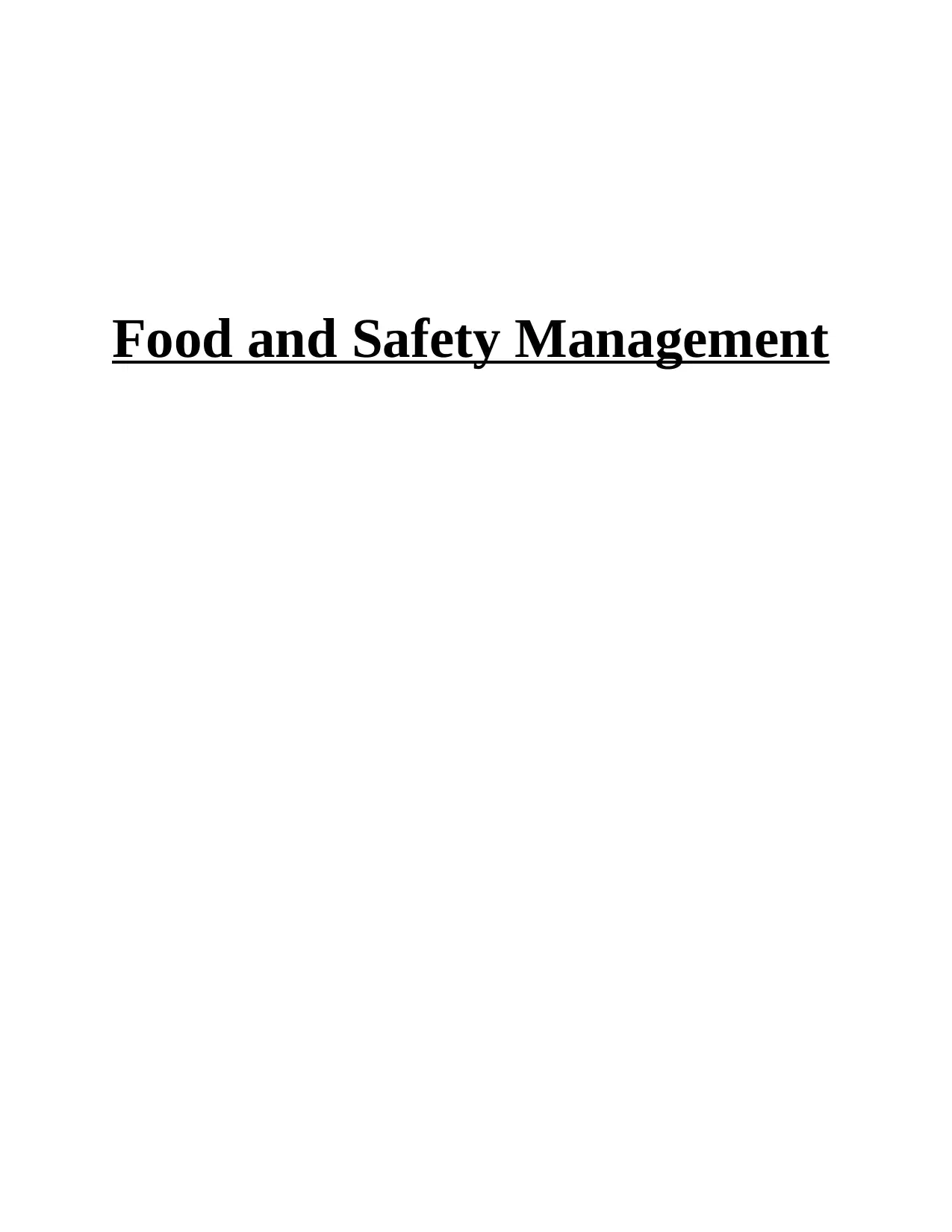
Food and Safety Management
Paraphrase This Document
Need a fresh take? Get an instant paraphrase of this document with our AI Paraphraser
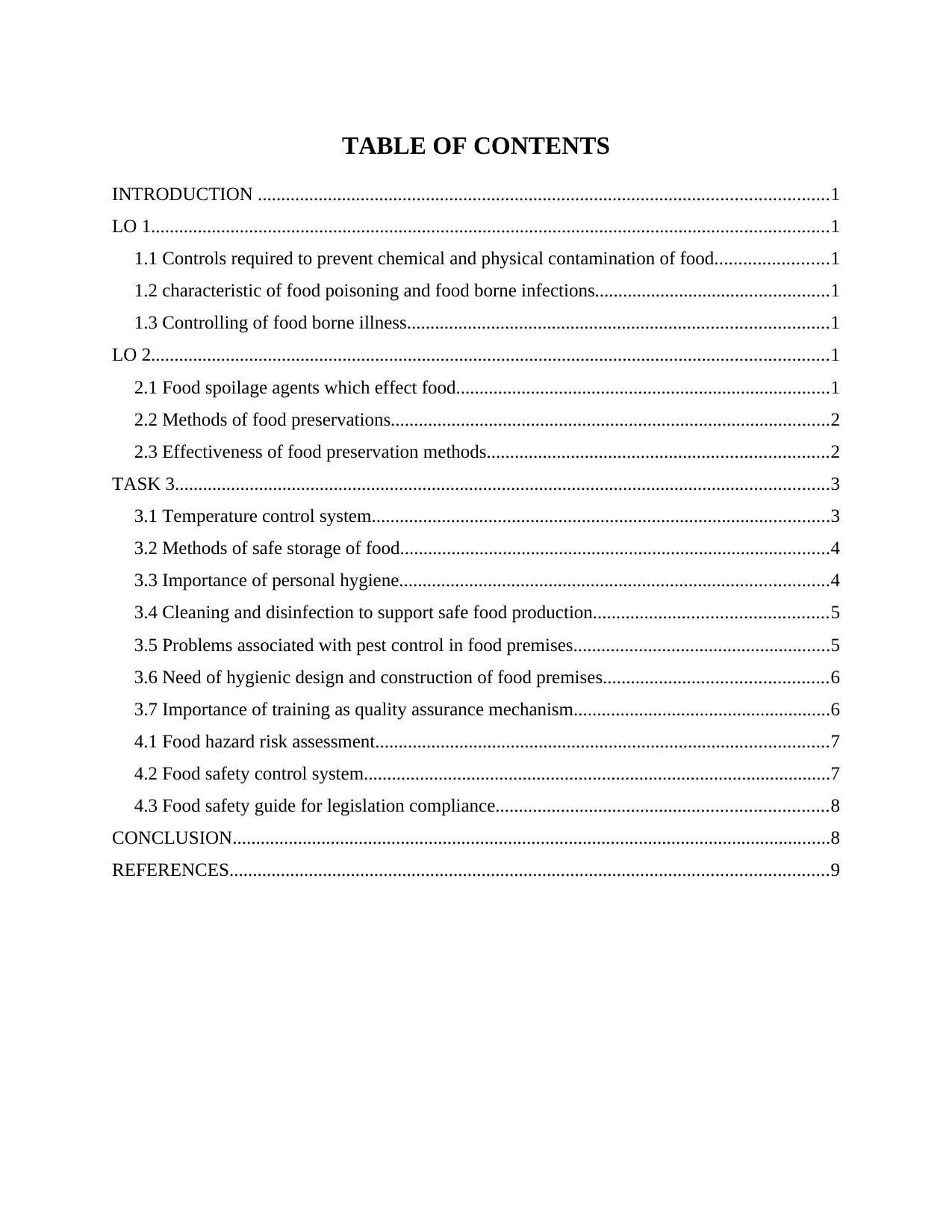
TABLE OF CONTENTS
INTRODUCTION ..........................................................................................................................1
LO 1.................................................................................................................................................1
1.1 Controls required to prevent chemical and physical contamination of food........................1
1.2 characteristic of food poisoning and food borne infections..................................................1
1.3 Controlling of food borne illness..........................................................................................1
LO 2.................................................................................................................................................1
2.1 Food spoilage agents which effect food................................................................................1
2.2 Methods of food preservations..............................................................................................2
2.3 Effectiveness of food preservation methods.........................................................................2
TASK 3............................................................................................................................................3
3.1 Temperature control system..................................................................................................3
3.2 Methods of safe storage of food............................................................................................4
3.3 Importance of personal hygiene............................................................................................4
3.4 Cleaning and disinfection to support safe food production..................................................5
3.5 Problems associated with pest control in food premises.......................................................5
3.6 Need of hygienic design and construction of food premises................................................6
3.7 Importance of training as quality assurance mechanism.......................................................6
4.1 Food hazard risk assessment.................................................................................................7
4.2 Food safety control system....................................................................................................7
4.3 Food safety guide for legislation compliance.......................................................................8
CONCLUSION................................................................................................................................8
REFERENCES................................................................................................................................9
INTRODUCTION ..........................................................................................................................1
LO 1.................................................................................................................................................1
1.1 Controls required to prevent chemical and physical contamination of food........................1
1.2 characteristic of food poisoning and food borne infections..................................................1
1.3 Controlling of food borne illness..........................................................................................1
LO 2.................................................................................................................................................1
2.1 Food spoilage agents which effect food................................................................................1
2.2 Methods of food preservations..............................................................................................2
2.3 Effectiveness of food preservation methods.........................................................................2
TASK 3............................................................................................................................................3
3.1 Temperature control system..................................................................................................3
3.2 Methods of safe storage of food............................................................................................4
3.3 Importance of personal hygiene............................................................................................4
3.4 Cleaning and disinfection to support safe food production..................................................5
3.5 Problems associated with pest control in food premises.......................................................5
3.6 Need of hygienic design and construction of food premises................................................6
3.7 Importance of training as quality assurance mechanism.......................................................6
4.1 Food hazard risk assessment.................................................................................................7
4.2 Food safety control system....................................................................................................7
4.3 Food safety guide for legislation compliance.......................................................................8
CONCLUSION................................................................................................................................8
REFERENCES................................................................................................................................9
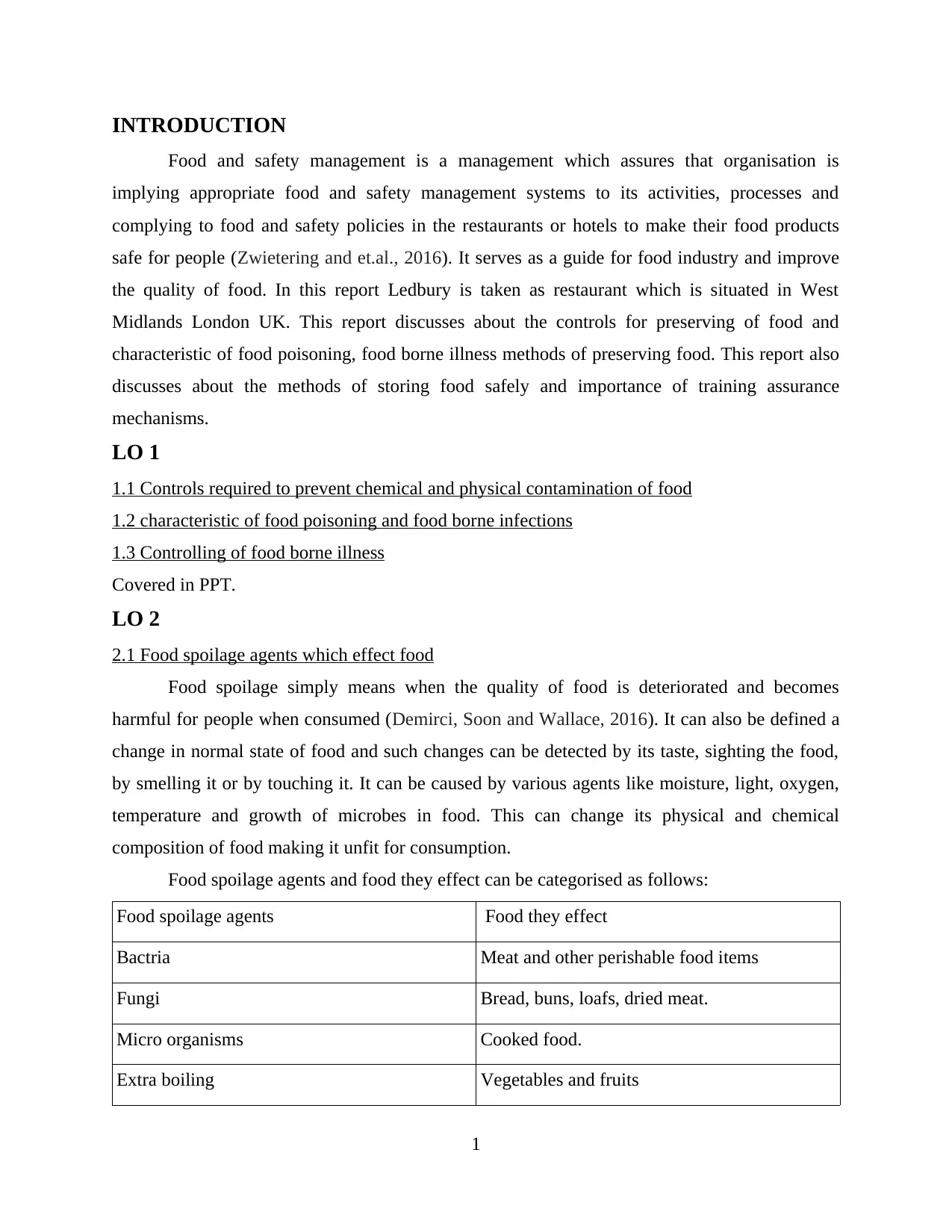
INTRODUCTION
Food and safety management is a management which assures that organisation is
implying appropriate food and safety management systems to its activities, processes and
complying to food and safety policies in the restaurants or hotels to make their food products
safe for people (Zwietering and et.al., 2016). It serves as a guide for food industry and improve
the quality of food. In this report Ledbury is taken as restaurant which is situated in West
Midlands London UK. This report discusses about the controls for preserving of food and
characteristic of food poisoning, food borne illness methods of preserving food. This report also
discusses about the methods of storing food safely and importance of training assurance
mechanisms.
LO 1
1.1 Controls required to prevent chemical and physical contamination of food
1.2 characteristic of food poisoning and food borne infections
1.3 Controlling of food borne illness
Covered in PPT.
LO 2
2.1 Food spoilage agents which effect food
Food spoilage simply means when the quality of food is deteriorated and becomes
harmful for people when consumed (Demirci, Soon and Wallace, 2016). It can also be defined a
change in normal state of food and such changes can be detected by its taste, sighting the food,
by smelling it or by touching it. It can be caused by various agents like moisture, light, oxygen,
temperature and growth of microbes in food. This can change its physical and chemical
composition of food making it unfit for consumption.
Food spoilage agents and food they effect can be categorised as follows:
Food spoilage agents Food they effect
Bactria Meat and other perishable food items
Fungi Bread, buns, loafs, dried meat.
Micro organisms Cooked food.
Extra boiling Vegetables and fruits
1
Food and safety management is a management which assures that organisation is
implying appropriate food and safety management systems to its activities, processes and
complying to food and safety policies in the restaurants or hotels to make their food products
safe for people (Zwietering and et.al., 2016). It serves as a guide for food industry and improve
the quality of food. In this report Ledbury is taken as restaurant which is situated in West
Midlands London UK. This report discusses about the controls for preserving of food and
characteristic of food poisoning, food borne illness methods of preserving food. This report also
discusses about the methods of storing food safely and importance of training assurance
mechanisms.
LO 1
1.1 Controls required to prevent chemical and physical contamination of food
1.2 characteristic of food poisoning and food borne infections
1.3 Controlling of food borne illness
Covered in PPT.
LO 2
2.1 Food spoilage agents which effect food
Food spoilage simply means when the quality of food is deteriorated and becomes
harmful for people when consumed (Demirci, Soon and Wallace, 2016). It can also be defined a
change in normal state of food and such changes can be detected by its taste, sighting the food,
by smelling it or by touching it. It can be caused by various agents like moisture, light, oxygen,
temperature and growth of microbes in food. This can change its physical and chemical
composition of food making it unfit for consumption.
Food spoilage agents and food they effect can be categorised as follows:
Food spoilage agents Food they effect
Bactria Meat and other perishable food items
Fungi Bread, buns, loafs, dried meat.
Micro organisms Cooked food.
Extra boiling Vegetables and fruits
1
⊘ This is a preview!⊘
Do you want full access?
Subscribe today to unlock all pages.

Trusted by 1+ million students worldwide
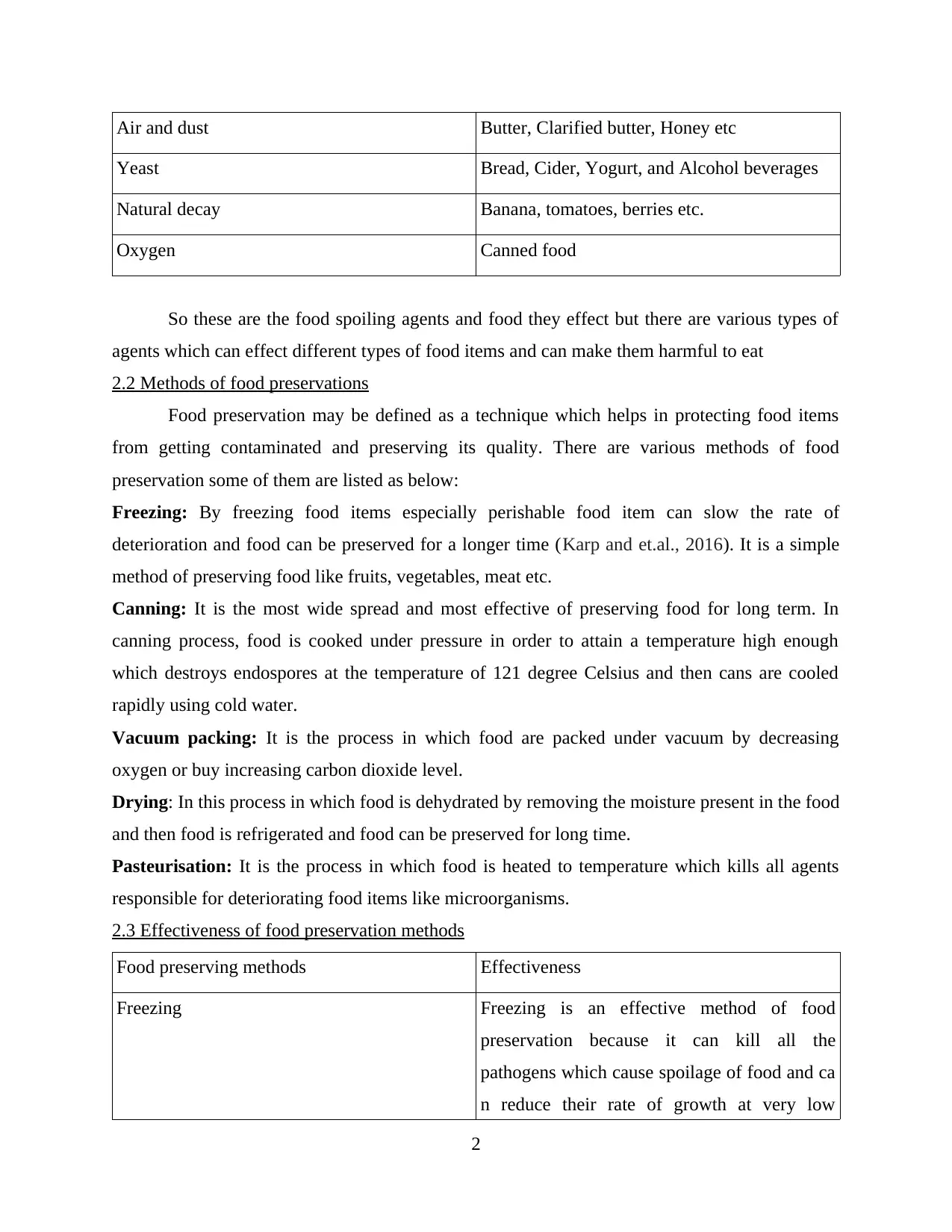
Air and dust Butter, Clarified butter, Honey etc
Yeast Bread, Cider, Yogurt, and Alcohol beverages
Natural decay Banana, tomatoes, berries etc.
Oxygen Canned food
So these are the food spoiling agents and food they effect but there are various types of
agents which can effect different types of food items and can make them harmful to eat
2.2 Methods of food preservations
Food preservation may be defined as a technique which helps in protecting food items
from getting contaminated and preserving its quality. There are various methods of food
preservation some of them are listed as below:
Freezing: By freezing food items especially perishable food item can slow the rate of
deterioration and food can be preserved for a longer time (Karp and et.al., 2016). It is a simple
method of preserving food like fruits, vegetables, meat etc.
Canning: It is the most wide spread and most effective of preserving food for long term. In
canning process, food is cooked under pressure in order to attain a temperature high enough
which destroys endospores at the temperature of 121 degree Celsius and then cans are cooled
rapidly using cold water.
Vacuum packing: It is the process in which food are packed under vacuum by decreasing
oxygen or buy increasing carbon dioxide level.
Drying: In this process in which food is dehydrated by removing the moisture present in the food
and then food is refrigerated and food can be preserved for long time.
Pasteurisation: It is the process in which food is heated to temperature which kills all agents
responsible for deteriorating food items like microorganisms.
2.3 Effectiveness of food preservation methods
Food preserving methods Effectiveness
Freezing Freezing is an effective method of food
preservation because it can kill all the
pathogens which cause spoilage of food and ca
n reduce their rate of growth at very low
2
Yeast Bread, Cider, Yogurt, and Alcohol beverages
Natural decay Banana, tomatoes, berries etc.
Oxygen Canned food
So these are the food spoiling agents and food they effect but there are various types of
agents which can effect different types of food items and can make them harmful to eat
2.2 Methods of food preservations
Food preservation may be defined as a technique which helps in protecting food items
from getting contaminated and preserving its quality. There are various methods of food
preservation some of them are listed as below:
Freezing: By freezing food items especially perishable food item can slow the rate of
deterioration and food can be preserved for a longer time (Karp and et.al., 2016). It is a simple
method of preserving food like fruits, vegetables, meat etc.
Canning: It is the most wide spread and most effective of preserving food for long term. In
canning process, food is cooked under pressure in order to attain a temperature high enough
which destroys endospores at the temperature of 121 degree Celsius and then cans are cooled
rapidly using cold water.
Vacuum packing: It is the process in which food are packed under vacuum by decreasing
oxygen or buy increasing carbon dioxide level.
Drying: In this process in which food is dehydrated by removing the moisture present in the food
and then food is refrigerated and food can be preserved for long time.
Pasteurisation: It is the process in which food is heated to temperature which kills all agents
responsible for deteriorating food items like microorganisms.
2.3 Effectiveness of food preservation methods
Food preserving methods Effectiveness
Freezing Freezing is an effective method of food
preservation because it can kill all the
pathogens which cause spoilage of food and ca
n reduce their rate of growth at very low
2
Paraphrase This Document
Need a fresh take? Get an instant paraphrase of this document with our AI Paraphraser
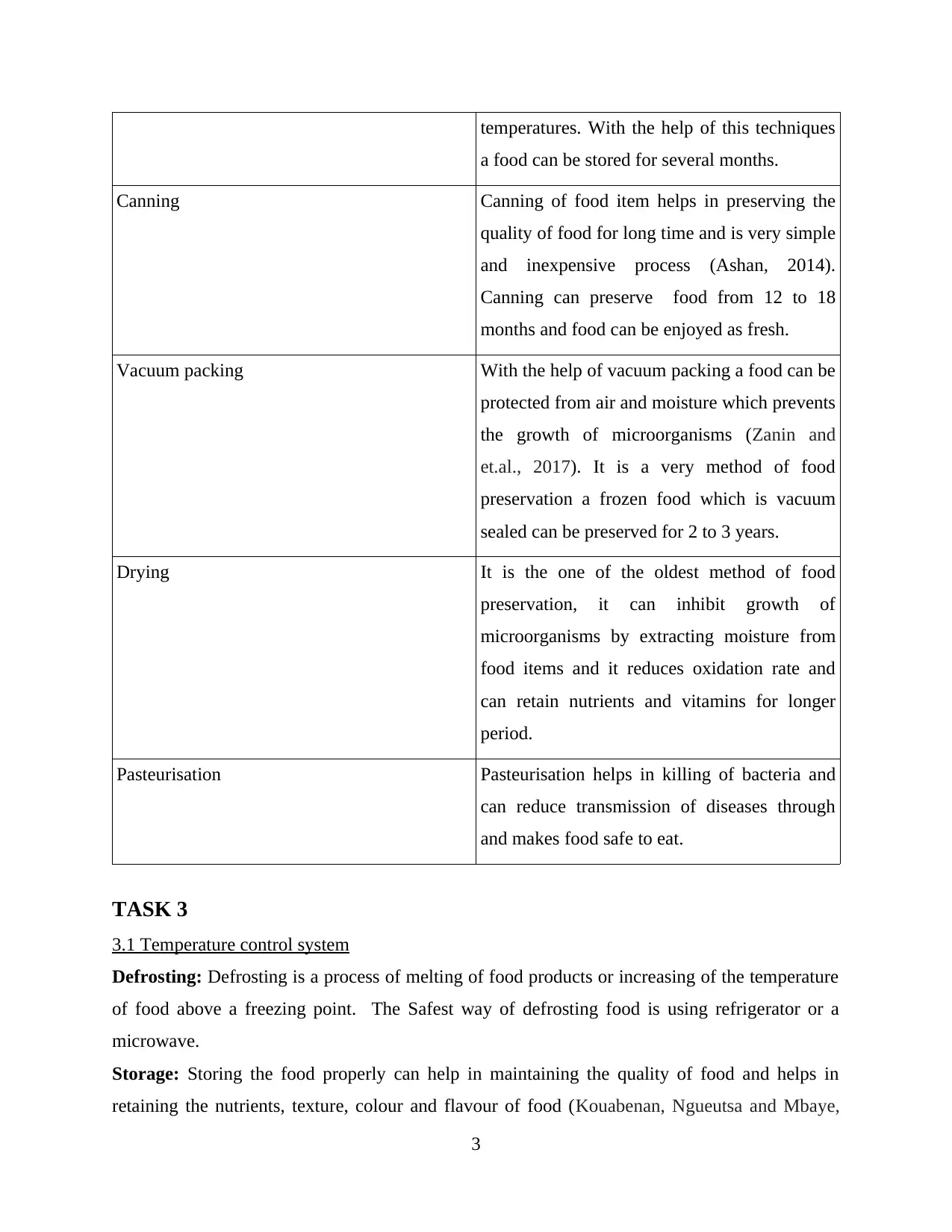
temperatures. With the help of this techniques
a food can be stored for several months.
Canning Canning of food item helps in preserving the
quality of food for long time and is very simple
and inexpensive process (Ashan, 2014).
Canning can preserve food from 12 to 18
months and food can be enjoyed as fresh.
Vacuum packing With the help of vacuum packing a food can be
protected from air and moisture which prevents
the growth of microorganisms (Zanin and
et.al., 2017). It is a very method of food
preservation a frozen food which is vacuum
sealed can be preserved for 2 to 3 years.
Drying It is the one of the oldest method of food
preservation, it can inhibit growth of
microorganisms by extracting moisture from
food items and it reduces oxidation rate and
can retain nutrients and vitamins for longer
period.
Pasteurisation Pasteurisation helps in killing of bacteria and
can reduce transmission of diseases through
and makes food safe to eat.
TASK 3
3.1 Temperature control system
Defrosting: Defrosting is a process of melting of food products or increasing of the temperature
of food above a freezing point. The Safest way of defrosting food is using refrigerator or a
microwave.
Storage: Storing the food properly can help in maintaining the quality of food and helps in
retaining the nutrients, texture, colour and flavour of food (Kouabenan, Ngueutsa and Mbaye,
3
a food can be stored for several months.
Canning Canning of food item helps in preserving the
quality of food for long time and is very simple
and inexpensive process (Ashan, 2014).
Canning can preserve food from 12 to 18
months and food can be enjoyed as fresh.
Vacuum packing With the help of vacuum packing a food can be
protected from air and moisture which prevents
the growth of microorganisms (Zanin and
et.al., 2017). It is a very method of food
preservation a frozen food which is vacuum
sealed can be preserved for 2 to 3 years.
Drying It is the one of the oldest method of food
preservation, it can inhibit growth of
microorganisms by extracting moisture from
food items and it reduces oxidation rate and
can retain nutrients and vitamins for longer
period.
Pasteurisation Pasteurisation helps in killing of bacteria and
can reduce transmission of diseases through
and makes food safe to eat.
TASK 3
3.1 Temperature control system
Defrosting: Defrosting is a process of melting of food products or increasing of the temperature
of food above a freezing point. The Safest way of defrosting food is using refrigerator or a
microwave.
Storage: Storing the food properly can help in maintaining the quality of food and helps in
retaining the nutrients, texture, colour and flavour of food (Kouabenan, Ngueutsa and Mbaye,
3
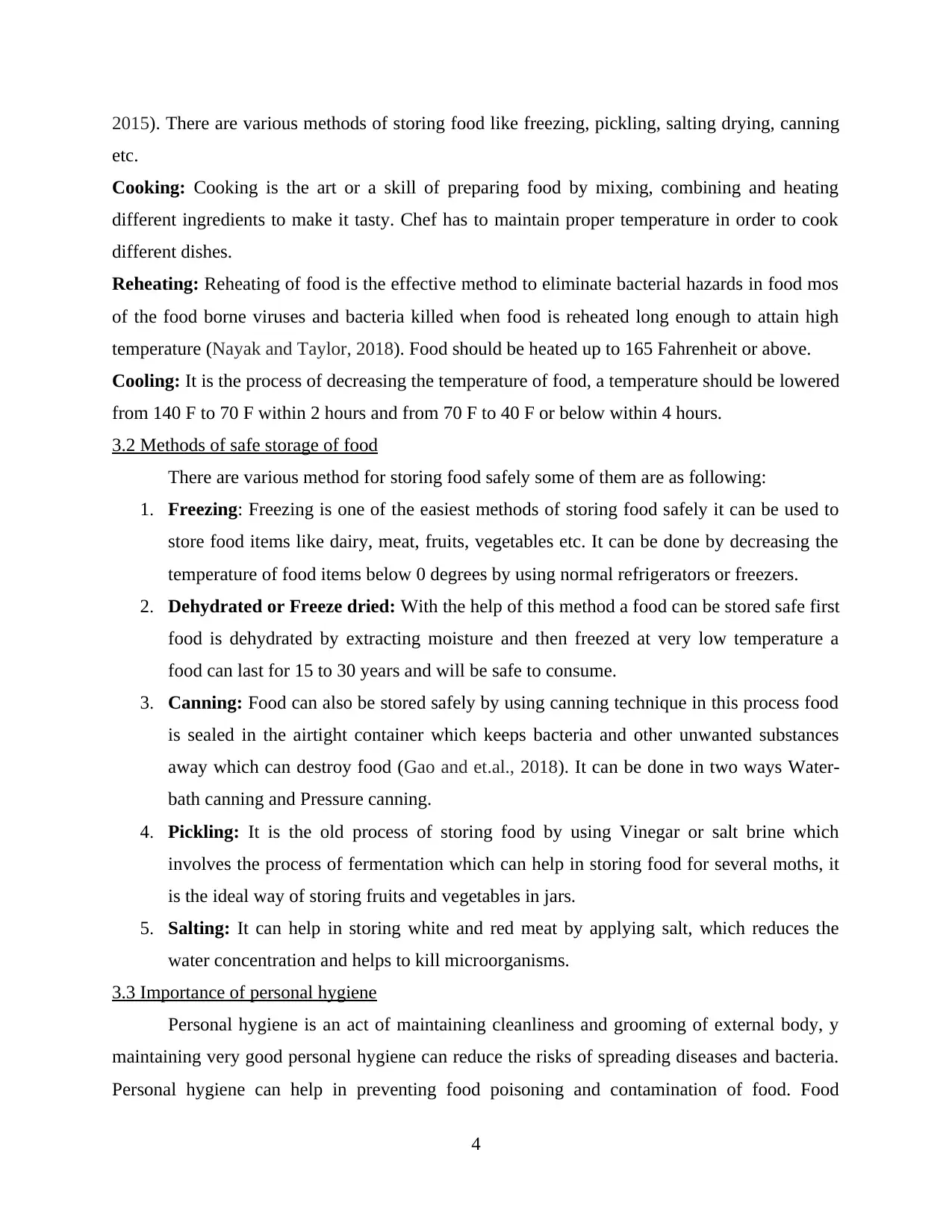
2015). There are various methods of storing food like freezing, pickling, salting drying, canning
etc.
Cooking: Cooking is the art or a skill of preparing food by mixing, combining and heating
different ingredients to make it tasty. Chef has to maintain proper temperature in order to cook
different dishes.
Reheating: Reheating of food is the effective method to eliminate bacterial hazards in food mos
of the food borne viruses and bacteria killed when food is reheated long enough to attain high
temperature (Nayak and Taylor, 2018). Food should be heated up to 165 Fahrenheit or above.
Cooling: It is the process of decreasing the temperature of food, a temperature should be lowered
from 140 F to 70 F within 2 hours and from 70 F to 40 F or below within 4 hours.
3.2 Methods of safe storage of food
There are various method for storing food safely some of them are as following:
1. Freezing: Freezing is one of the easiest methods of storing food safely it can be used to
store food items like dairy, meat, fruits, vegetables etc. It can be done by decreasing the
temperature of food items below 0 degrees by using normal refrigerators or freezers.
2. Dehydrated or Freeze dried: With the help of this method a food can be stored safe first
food is dehydrated by extracting moisture and then freezed at very low temperature a
food can last for 15 to 30 years and will be safe to consume.
3. Canning: Food can also be stored safely by using canning technique in this process food
is sealed in the airtight container which keeps bacteria and other unwanted substances
away which can destroy food (Gao and et.al., 2018). It can be done in two ways Water-
bath canning and Pressure canning.
4. Pickling: It is the old process of storing food by using Vinegar or salt brine which
involves the process of fermentation which can help in storing food for several moths, it
is the ideal way of storing fruits and vegetables in jars.
5. Salting: It can help in storing white and red meat by applying salt, which reduces the
water concentration and helps to kill microorganisms.
3.3 Importance of personal hygiene
Personal hygiene is an act of maintaining cleanliness and grooming of external body, y
maintaining very good personal hygiene can reduce the risks of spreading diseases and bacteria.
Personal hygiene can help in preventing food poisoning and contamination of food. Food
4
etc.
Cooking: Cooking is the art or a skill of preparing food by mixing, combining and heating
different ingredients to make it tasty. Chef has to maintain proper temperature in order to cook
different dishes.
Reheating: Reheating of food is the effective method to eliminate bacterial hazards in food mos
of the food borne viruses and bacteria killed when food is reheated long enough to attain high
temperature (Nayak and Taylor, 2018). Food should be heated up to 165 Fahrenheit or above.
Cooling: It is the process of decreasing the temperature of food, a temperature should be lowered
from 140 F to 70 F within 2 hours and from 70 F to 40 F or below within 4 hours.
3.2 Methods of safe storage of food
There are various method for storing food safely some of them are as following:
1. Freezing: Freezing is one of the easiest methods of storing food safely it can be used to
store food items like dairy, meat, fruits, vegetables etc. It can be done by decreasing the
temperature of food items below 0 degrees by using normal refrigerators or freezers.
2. Dehydrated or Freeze dried: With the help of this method a food can be stored safe first
food is dehydrated by extracting moisture and then freezed at very low temperature a
food can last for 15 to 30 years and will be safe to consume.
3. Canning: Food can also be stored safely by using canning technique in this process food
is sealed in the airtight container which keeps bacteria and other unwanted substances
away which can destroy food (Gao and et.al., 2018). It can be done in two ways Water-
bath canning and Pressure canning.
4. Pickling: It is the old process of storing food by using Vinegar or salt brine which
involves the process of fermentation which can help in storing food for several moths, it
is the ideal way of storing fruits and vegetables in jars.
5. Salting: It can help in storing white and red meat by applying salt, which reduces the
water concentration and helps to kill microorganisms.
3.3 Importance of personal hygiene
Personal hygiene is an act of maintaining cleanliness and grooming of external body, y
maintaining very good personal hygiene can reduce the risks of spreading diseases and bacteria.
Personal hygiene can help in preventing food poisoning and contamination of food. Food
4
⊘ This is a preview!⊘
Do you want full access?
Subscribe today to unlock all pages.

Trusted by 1+ million students worldwide
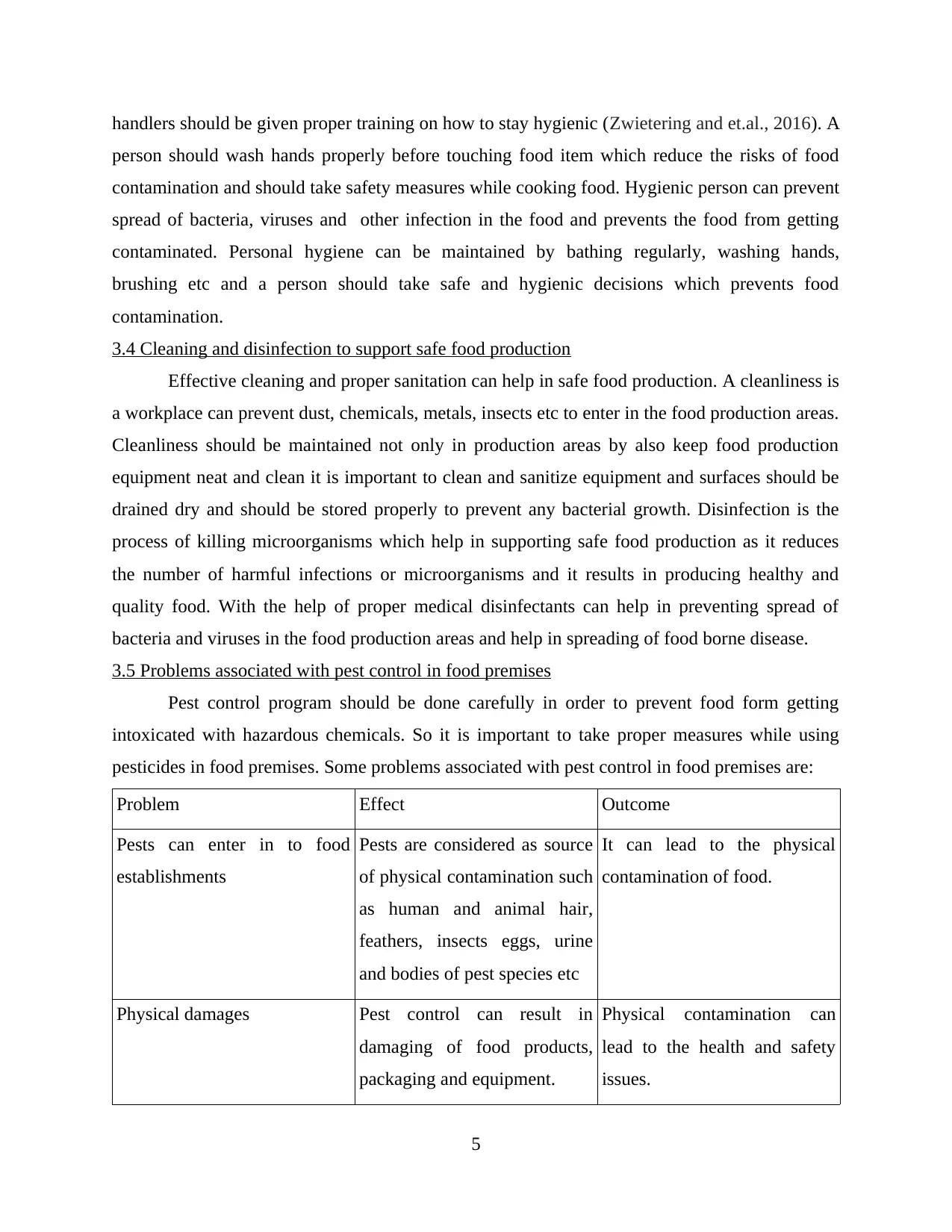
handlers should be given proper training on how to stay hygienic (Zwietering and et.al., 2016). A
person should wash hands properly before touching food item which reduce the risks of food
contamination and should take safety measures while cooking food. Hygienic person can prevent
spread of bacteria, viruses and other infection in the food and prevents the food from getting
contaminated. Personal hygiene can be maintained by bathing regularly, washing hands,
brushing etc and a person should take safe and hygienic decisions which prevents food
contamination.
3.4 Cleaning and disinfection to support safe food production
Effective cleaning and proper sanitation can help in safe food production. A cleanliness is
a workplace can prevent dust, chemicals, metals, insects etc to enter in the food production areas.
Cleanliness should be maintained not only in production areas by also keep food production
equipment neat and clean it is important to clean and sanitize equipment and surfaces should be
drained dry and should be stored properly to prevent any bacterial growth. Disinfection is the
process of killing microorganisms which help in supporting safe food production as it reduces
the number of harmful infections or microorganisms and it results in producing healthy and
quality food. With the help of proper medical disinfectants can help in preventing spread of
bacteria and viruses in the food production areas and help in spreading of food borne disease.
3.5 Problems associated with pest control in food premises
Pest control program should be done carefully in order to prevent food form getting
intoxicated with hazardous chemicals. So it is important to take proper measures while using
pesticides in food premises. Some problems associated with pest control in food premises are:
Problem Effect Outcome
Pests can enter in to food
establishments
Pests are considered as source
of physical contamination such
as human and animal hair,
feathers, insects eggs, urine
and bodies of pest species etc
It can lead to the physical
contamination of food.
Physical damages Pest control can result in
damaging of food products,
packaging and equipment.
Physical contamination can
lead to the health and safety
issues.
5
person should wash hands properly before touching food item which reduce the risks of food
contamination and should take safety measures while cooking food. Hygienic person can prevent
spread of bacteria, viruses and other infection in the food and prevents the food from getting
contaminated. Personal hygiene can be maintained by bathing regularly, washing hands,
brushing etc and a person should take safe and hygienic decisions which prevents food
contamination.
3.4 Cleaning and disinfection to support safe food production
Effective cleaning and proper sanitation can help in safe food production. A cleanliness is
a workplace can prevent dust, chemicals, metals, insects etc to enter in the food production areas.
Cleanliness should be maintained not only in production areas by also keep food production
equipment neat and clean it is important to clean and sanitize equipment and surfaces should be
drained dry and should be stored properly to prevent any bacterial growth. Disinfection is the
process of killing microorganisms which help in supporting safe food production as it reduces
the number of harmful infections or microorganisms and it results in producing healthy and
quality food. With the help of proper medical disinfectants can help in preventing spread of
bacteria and viruses in the food production areas and help in spreading of food borne disease.
3.5 Problems associated with pest control in food premises
Pest control program should be done carefully in order to prevent food form getting
intoxicated with hazardous chemicals. So it is important to take proper measures while using
pesticides in food premises. Some problems associated with pest control in food premises are:
Problem Effect Outcome
Pests can enter in to food
establishments
Pests are considered as source
of physical contamination such
as human and animal hair,
feathers, insects eggs, urine
and bodies of pest species etc
It can lead to the physical
contamination of food.
Physical damages Pest control can result in
damaging of food products,
packaging and equipment.
Physical contamination can
lead to the health and safety
issues.
5
Paraphrase This Document
Need a fresh take? Get an instant paraphrase of this document with our AI Paraphraser
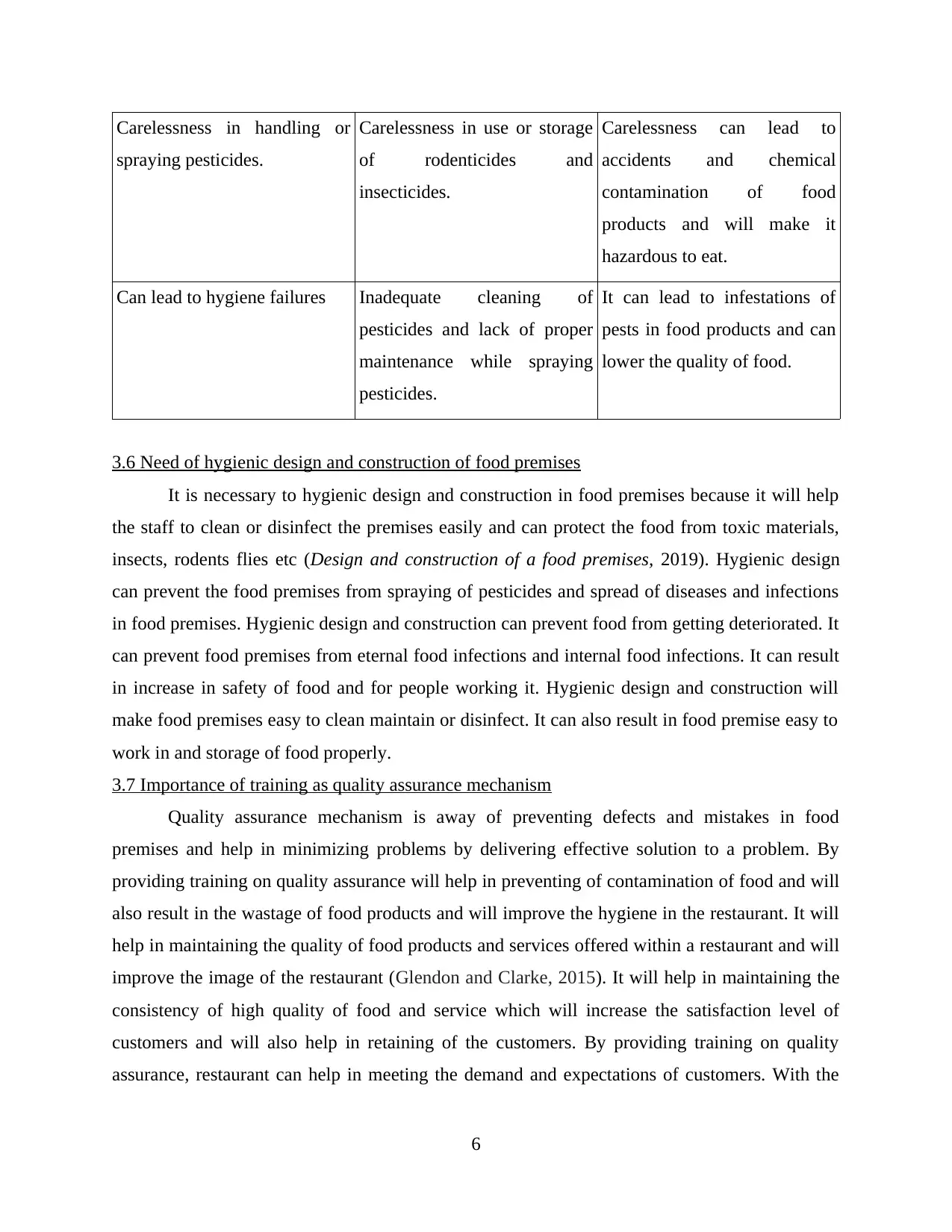
Carelessness in handling or
spraying pesticides.
Carelessness in use or storage
of rodenticides and
insecticides.
Carelessness can lead to
accidents and chemical
contamination of food
products and will make it
hazardous to eat.
Can lead to hygiene failures Inadequate cleaning of
pesticides and lack of proper
maintenance while spraying
pesticides.
It can lead to infestations of
pests in food products and can
lower the quality of food.
3.6 Need of hygienic design and construction of food premises
It is necessary to hygienic design and construction in food premises because it will help
the staff to clean or disinfect the premises easily and can protect the food from toxic materials,
insects, rodents flies etc (Design and construction of a food premises, 2019). Hygienic design
can prevent the food premises from spraying of pesticides and spread of diseases and infections
in food premises. Hygienic design and construction can prevent food from getting deteriorated. It
can prevent food premises from eternal food infections and internal food infections. It can result
in increase in safety of food and for people working it. Hygienic design and construction will
make food premises easy to clean maintain or disinfect. It can also result in food premise easy to
work in and storage of food properly.
3.7 Importance of training as quality assurance mechanism
Quality assurance mechanism is away of preventing defects and mistakes in food
premises and help in minimizing problems by delivering effective solution to a problem. By
providing training on quality assurance will help in preventing of contamination of food and will
also result in the wastage of food products and will improve the hygiene in the restaurant. It will
help in maintaining the quality of food products and services offered within a restaurant and will
improve the image of the restaurant (Glendon and Clarke, 2015). It will help in maintaining the
consistency of high quality of food and service which will increase the satisfaction level of
customers and will also help in retaining of the customers. By providing training on quality
assurance, restaurant can help in meeting the demand and expectations of customers. With the
6
spraying pesticides.
Carelessness in use or storage
of rodenticides and
insecticides.
Carelessness can lead to
accidents and chemical
contamination of food
products and will make it
hazardous to eat.
Can lead to hygiene failures Inadequate cleaning of
pesticides and lack of proper
maintenance while spraying
pesticides.
It can lead to infestations of
pests in food products and can
lower the quality of food.
3.6 Need of hygienic design and construction of food premises
It is necessary to hygienic design and construction in food premises because it will help
the staff to clean or disinfect the premises easily and can protect the food from toxic materials,
insects, rodents flies etc (Design and construction of a food premises, 2019). Hygienic design
can prevent the food premises from spraying of pesticides and spread of diseases and infections
in food premises. Hygienic design and construction can prevent food from getting deteriorated. It
can prevent food premises from eternal food infections and internal food infections. It can result
in increase in safety of food and for people working it. Hygienic design and construction will
make food premises easy to clean maintain or disinfect. It can also result in food premise easy to
work in and storage of food properly.
3.7 Importance of training as quality assurance mechanism
Quality assurance mechanism is away of preventing defects and mistakes in food
premises and help in minimizing problems by delivering effective solution to a problem. By
providing training on quality assurance will help in preventing of contamination of food and will
also result in the wastage of food products and will improve the hygiene in the restaurant. It will
help in maintaining the quality of food products and services offered within a restaurant and will
improve the image of the restaurant (Glendon and Clarke, 2015). It will help in maintaining the
consistency of high quality of food and service which will increase the satisfaction level of
customers and will also help in retaining of the customers. By providing training on quality
assurance, restaurant can help in meeting the demand and expectations of customers. With the
6
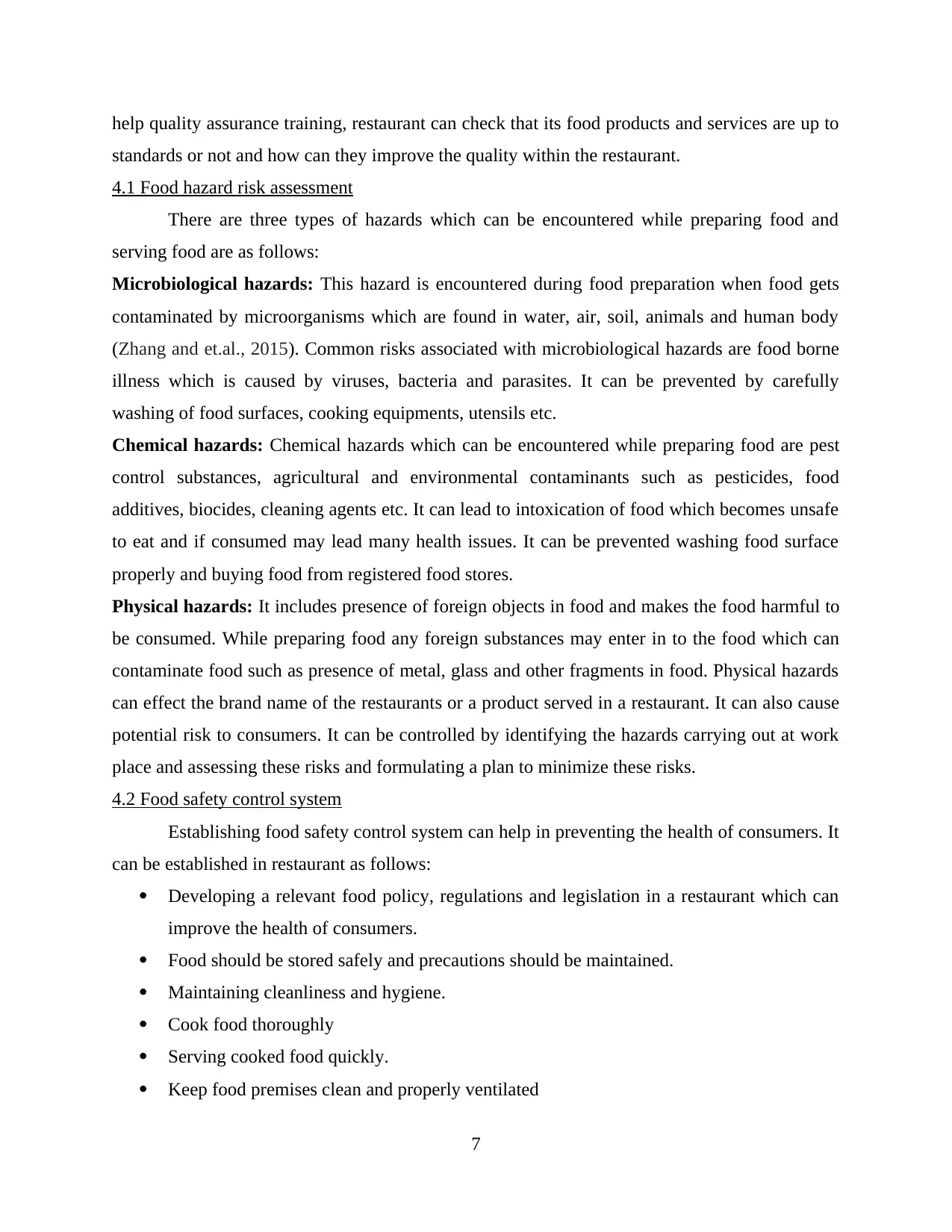
help quality assurance training, restaurant can check that its food products and services are up to
standards or not and how can they improve the quality within the restaurant.
4.1 Food hazard risk assessment
There are three types of hazards which can be encountered while preparing food and
serving food are as follows:
Microbiological hazards: This hazard is encountered during food preparation when food gets
contaminated by microorganisms which are found in water, air, soil, animals and human body
(Zhang and et.al., 2015). Common risks associated with microbiological hazards are food borne
illness which is caused by viruses, bacteria and parasites. It can be prevented by carefully
washing of food surfaces, cooking equipments, utensils etc.
Chemical hazards: Chemical hazards which can be encountered while preparing food are pest
control substances, agricultural and environmental contaminants such as pesticides, food
additives, biocides, cleaning agents etc. It can lead to intoxication of food which becomes unsafe
to eat and if consumed may lead many health issues. It can be prevented washing food surface
properly and buying food from registered food stores.
Physical hazards: It includes presence of foreign objects in food and makes the food harmful to
be consumed. While preparing food any foreign substances may enter in to the food which can
contaminate food such as presence of metal, glass and other fragments in food. Physical hazards
can effect the brand name of the restaurants or a product served in a restaurant. It can also cause
potential risk to consumers. It can be controlled by identifying the hazards carrying out at work
place and assessing these risks and formulating a plan to minimize these risks.
4.2 Food safety control system
Establishing food safety control system can help in preventing the health of consumers. It
can be established in restaurant as follows:
Developing a relevant food policy, regulations and legislation in a restaurant which can
improve the health of consumers.
Food should be stored safely and precautions should be maintained.
Maintaining cleanliness and hygiene.
Cook food thoroughly
Serving cooked food quickly.
Keep food premises clean and properly ventilated
7
standards or not and how can they improve the quality within the restaurant.
4.1 Food hazard risk assessment
There are three types of hazards which can be encountered while preparing food and
serving food are as follows:
Microbiological hazards: This hazard is encountered during food preparation when food gets
contaminated by microorganisms which are found in water, air, soil, animals and human body
(Zhang and et.al., 2015). Common risks associated with microbiological hazards are food borne
illness which is caused by viruses, bacteria and parasites. It can be prevented by carefully
washing of food surfaces, cooking equipments, utensils etc.
Chemical hazards: Chemical hazards which can be encountered while preparing food are pest
control substances, agricultural and environmental contaminants such as pesticides, food
additives, biocides, cleaning agents etc. It can lead to intoxication of food which becomes unsafe
to eat and if consumed may lead many health issues. It can be prevented washing food surface
properly and buying food from registered food stores.
Physical hazards: It includes presence of foreign objects in food and makes the food harmful to
be consumed. While preparing food any foreign substances may enter in to the food which can
contaminate food such as presence of metal, glass and other fragments in food. Physical hazards
can effect the brand name of the restaurants or a product served in a restaurant. It can also cause
potential risk to consumers. It can be controlled by identifying the hazards carrying out at work
place and assessing these risks and formulating a plan to minimize these risks.
4.2 Food safety control system
Establishing food safety control system can help in preventing the health of consumers. It
can be established in restaurant as follows:
Developing a relevant food policy, regulations and legislation in a restaurant which can
improve the health of consumers.
Food should be stored safely and precautions should be maintained.
Maintaining cleanliness and hygiene.
Cook food thoroughly
Serving cooked food quickly.
Keep food premises clean and properly ventilated
7
⊘ This is a preview!⊘
Do you want full access?
Subscribe today to unlock all pages.

Trusted by 1+ million students worldwide
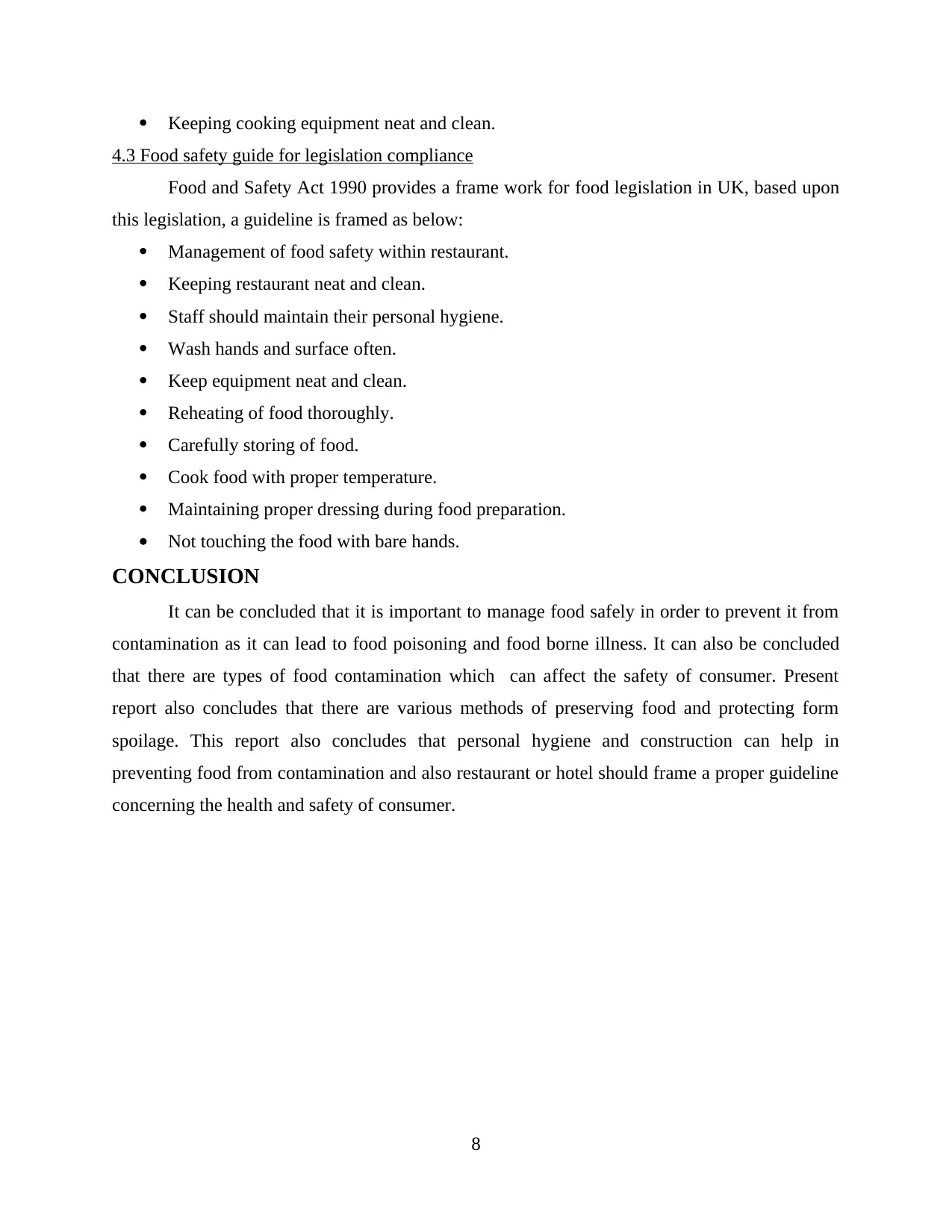
Keeping cooking equipment neat and clean.
4.3 Food safety guide for legislation compliance
Food and Safety Act 1990 provides a frame work for food legislation in UK, based upon
this legislation, a guideline is framed as below:
Management of food safety within restaurant.
Keeping restaurant neat and clean.
Staff should maintain their personal hygiene.
Wash hands and surface often.
Keep equipment neat and clean.
Reheating of food thoroughly.
Carefully storing of food.
Cook food with proper temperature.
Maintaining proper dressing during food preparation.
Not touching the food with bare hands.
CONCLUSION
It can be concluded that it is important to manage food safely in order to prevent it from
contamination as it can lead to food poisoning and food borne illness. It can also be concluded
that there are types of food contamination which can affect the safety of consumer. Present
report also concludes that there are various methods of preserving food and protecting form
spoilage. This report also concludes that personal hygiene and construction can help in
preventing food from contamination and also restaurant or hotel should frame a proper guideline
concerning the health and safety of consumer.
8
4.3 Food safety guide for legislation compliance
Food and Safety Act 1990 provides a frame work for food legislation in UK, based upon
this legislation, a guideline is framed as below:
Management of food safety within restaurant.
Keeping restaurant neat and clean.
Staff should maintain their personal hygiene.
Wash hands and surface often.
Keep equipment neat and clean.
Reheating of food thoroughly.
Carefully storing of food.
Cook food with proper temperature.
Maintaining proper dressing during food preparation.
Not touching the food with bare hands.
CONCLUSION
It can be concluded that it is important to manage food safely in order to prevent it from
contamination as it can lead to food poisoning and food borne illness. It can also be concluded
that there are types of food contamination which can affect the safety of consumer. Present
report also concludes that there are various methods of preserving food and protecting form
spoilage. This report also concludes that personal hygiene and construction can help in
preventing food from contamination and also restaurant or hotel should frame a proper guideline
concerning the health and safety of consumer.
8
Paraphrase This Document
Need a fresh take? Get an instant paraphrase of this document with our AI Paraphraser
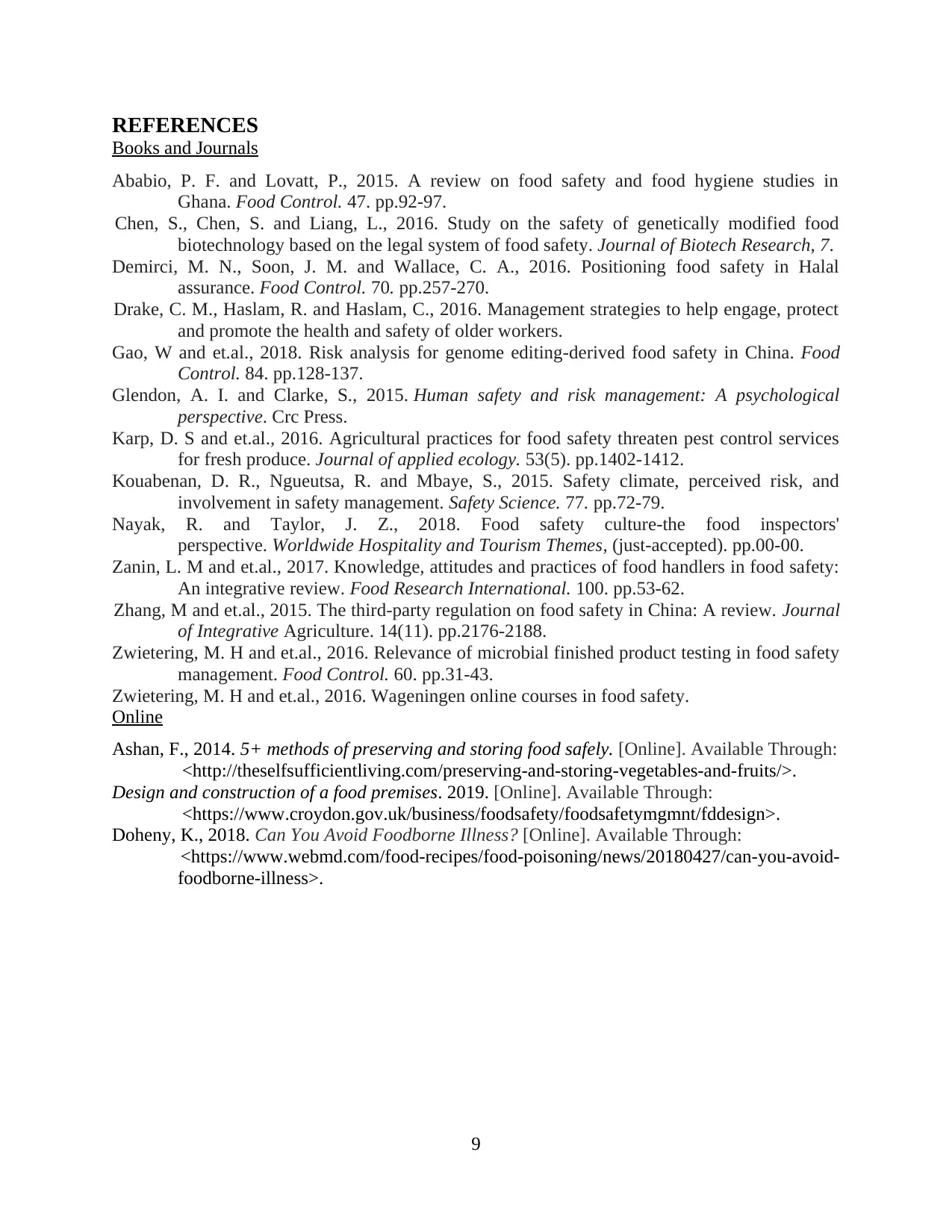
REFERENCES
Books and Journals
Ababio, P. F. and Lovatt, P., 2015. A review on food safety and food hygiene studies in
Ghana. Food Control. 47. pp.92-97.
Chen, S., Chen, S. and Liang, L., 2016. Study on the safety of genetically modified food
biotechnology based on the legal system of food safety. Journal of Biotech Research, 7.
Demirci, M. N., Soon, J. M. and Wallace, C. A., 2016. Positioning food safety in Halal
assurance. Food Control. 70. pp.257-270.
Drake, C. M., Haslam, R. and Haslam, C., 2016. Management strategies to help engage, protect
and promote the health and safety of older workers.
Gao, W and et.al., 2018. Risk analysis for genome editing-derived food safety in China. Food
Control. 84. pp.128-137.
Glendon, A. I. and Clarke, S., 2015. Human safety and risk management: A psychological
perspective. Crc Press.
Karp, D. S and et.al., 2016. Agricultural practices for food safety threaten pest control services
for fresh produce. Journal of applied ecology. 53(5). pp.1402-1412.
Kouabenan, D. R., Ngueutsa, R. and Mbaye, S., 2015. Safety climate, perceived risk, and
involvement in safety management. Safety Science. 77. pp.72-79.
Nayak, R. and Taylor, J. Z., 2018. Food safety culture-the food inspectors'
perspective. Worldwide Hospitality and Tourism Themes, (just-accepted). pp.00-00.
Zanin, L. M and et.al., 2017. Knowledge, attitudes and practices of food handlers in food safety:
An integrative review. Food Research International. 100. pp.53-62.
Zhang, M and et.al., 2015. The third-party regulation on food safety in China: A review. Journal
of Integrative Agriculture. 14(11). pp.2176-2188.
Zwietering, M. H and et.al., 2016. Relevance of microbial finished product testing in food safety
management. Food Control. 60. pp.31-43.
Zwietering, M. H and et.al., 2016. Wageningen online courses in food safety.
Online
Ashan, F., 2014. 5+ methods of preserving and storing food safely. [Online]. Available Through:
<http://theselfsufficientliving.com/preserving-and-storing-vegetables-and-fruits/>.
Design and construction of a food premises. 2019. [Online]. Available Through:
<https://www.croydon.gov.uk/business/foodsafety/foodsafetymgmnt/fddesign>.
Doheny, K., 2018. Can You Avoid Foodborne Illness? [Online]. Available Through:
<https://www.webmd.com/food-recipes/food-poisoning/news/20180427/can-you-avoid-
foodborne-illness>.
9
Books and Journals
Ababio, P. F. and Lovatt, P., 2015. A review on food safety and food hygiene studies in
Ghana. Food Control. 47. pp.92-97.
Chen, S., Chen, S. and Liang, L., 2016. Study on the safety of genetically modified food
biotechnology based on the legal system of food safety. Journal of Biotech Research, 7.
Demirci, M. N., Soon, J. M. and Wallace, C. A., 2016. Positioning food safety in Halal
assurance. Food Control. 70. pp.257-270.
Drake, C. M., Haslam, R. and Haslam, C., 2016. Management strategies to help engage, protect
and promote the health and safety of older workers.
Gao, W and et.al., 2018. Risk analysis for genome editing-derived food safety in China. Food
Control. 84. pp.128-137.
Glendon, A. I. and Clarke, S., 2015. Human safety and risk management: A psychological
perspective. Crc Press.
Karp, D. S and et.al., 2016. Agricultural practices for food safety threaten pest control services
for fresh produce. Journal of applied ecology. 53(5). pp.1402-1412.
Kouabenan, D. R., Ngueutsa, R. and Mbaye, S., 2015. Safety climate, perceived risk, and
involvement in safety management. Safety Science. 77. pp.72-79.
Nayak, R. and Taylor, J. Z., 2018. Food safety culture-the food inspectors'
perspective. Worldwide Hospitality and Tourism Themes, (just-accepted). pp.00-00.
Zanin, L. M and et.al., 2017. Knowledge, attitudes and practices of food handlers in food safety:
An integrative review. Food Research International. 100. pp.53-62.
Zhang, M and et.al., 2015. The third-party regulation on food safety in China: A review. Journal
of Integrative Agriculture. 14(11). pp.2176-2188.
Zwietering, M. H and et.al., 2016. Relevance of microbial finished product testing in food safety
management. Food Control. 60. pp.31-43.
Zwietering, M. H and et.al., 2016. Wageningen online courses in food safety.
Online
Ashan, F., 2014. 5+ methods of preserving and storing food safely. [Online]. Available Through:
<http://theselfsufficientliving.com/preserving-and-storing-vegetables-and-fruits/>.
Design and construction of a food premises. 2019. [Online]. Available Through:
<https://www.croydon.gov.uk/business/foodsafety/foodsafetymgmnt/fddesign>.
Doheny, K., 2018. Can You Avoid Foodborne Illness? [Online]. Available Through:
<https://www.webmd.com/food-recipes/food-poisoning/news/20180427/can-you-avoid-
foodborne-illness>.
9
1 out of 11
Related Documents
Your All-in-One AI-Powered Toolkit for Academic Success.
+13062052269
info@desklib.com
Available 24*7 on WhatsApp / Email
![[object Object]](/_next/static/media/star-bottom.7253800d.svg)
Unlock your academic potential
Copyright © 2020–2025 A2Z Services. All Rights Reserved. Developed and managed by ZUCOL.





